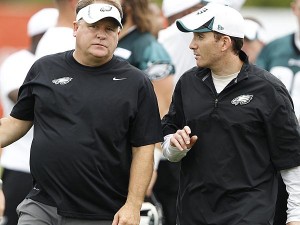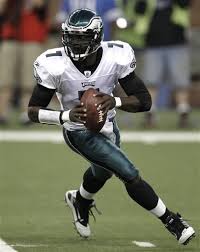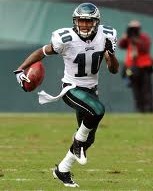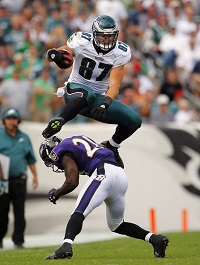[adsenseyu1]
How do you build a winning football team? Over the next few weeks I am going to look at a handful of teams that are either relatively early in their rebuilding process or on the verge of a possible rebuild. The purpose of this is not to reflect on past regime decisions compared to the current decisions but rather to start the analysis from day one and evaluate personnel decisions along with contract structures and styles to see if certain trends help produce a winning franchise.
State of the Franchise and Front Office
There might not be a team in the NFL with more question marks heading into the 2013 season than the Philadelphia Eagles. Like most of the teams featured in this series, the Eagles have greatly underachieved and fallen far short of expectations in recent years. After the “Dream Team” stumbled to a disappointing 8-8 record in 2011, the wheels really fell off the wagon in 2012. A 4-12 season was bound to come with serious consequences, and none was greater than the departure of longtime Head Coach Andy Reid. The awful 2012 season was the final straw that ended a 14-year tenure that included 9 playoff appearances, 6 NFC East Division Titles, 5 NFC Championship Game Appearances, 1 Super Bowl Appearance, but no Lombardi Trophies. Reid wasn’t on the market for long, as he quickly agreed to become the Head Coach of the Kansas City Chiefs.

HC Chip Kelly and GM Howie Roseman
One man who survived was General Manager Howie Roseman. Entering his fourth season as GM, Roseman is going to be the longest tenured General Manager in our case study. The University of Florida and Fordham Law School graduate now faces at least a partial rebuild after two incredibly disappointing seasons following an NFC East Division title in his first year as GM in 2010. Roseman grabbed one of the biggest headlines of the offseason when he successfully lured offensive-guru Chip Kelly from Oregon to become the 21st Head Coach of the Eagles even after Kelly announced he was going to remain at Oregon.
While the Eagles may not be a contender right now, the team still a ton of cap room and serious talent across its roster. The Eagles currently have just under $21 million in cap room despite eating some dead money costs after moving on from 2011 1st round pick Danny Watkins and 2011 free agent prizes Nnamdi Asomugha and Jason Babin. In the NFC East, a division with no clear-cut favorites yet again, the Eagles might be able to make some noise while also transitioning their roster.
Contract Strategies and Trends
Although we have a lot more data available due to Roseman’s longer tenure, I’m still going to keep the analysis consistent with the theme of State of Rebuild and try to only look at the more recent moves. The Eagles seemingly use most of the contractual tools we have been going over including the standard roster bonuses, per-game roster bonuses, workout bonuses, and the Minimum Salary Benefit (Felix Jones). What is more interesting is the amount of money the contracts are actually worth relevant to the rest of the league. Players such as Lesean McCoy (3rd), Jason Peters (1st), Trent Cole (5th), DeSean Jackson (8th), Connor Barwin (10th) and Todd Herremans (10th after switch to Guard) are all being paid near the top of their positions on an Average Per Year basis. While the Average Per Year amount of a contract isn’t by any means a full-proof barometer, the Eagles have an exorbitant amount of players being paid near the top of their respective positions for a team that has struggled so mightily. This isn’t to say that they aren’t very good players, but it is interesting to me that a team with so many highly paid talented players is now trying to find a way to re-do their roster.
The Eagles do have a few interesting contracts on the books that I felt would be worth taking a look at. The Eagles are another one of the teams we have looked at recently that have used a very low P5 (base) salary and a high roster bonus in the first year of a new deal. Some of the Eagles players with this setup include DT Isaako Sopoaga, S Patrick Chung, FB James Casey, and CB Bradley Fletcher. Just as a brief refresher, this type of deal gives the team some cap flexibility by limiting 3rd year guarantees and prorated bonuses while it gives the player the money up front and protects against potential forfeitures.
There is one more little nuance to these four deals that I found particularly interesting. There are no official Team or Player option contracts in the NFL like you see in some of the other major sports, but the way the Eagles structured these contracts essentially turn them into 1 year deals with 1 or 2 yearly team options. As an example we’ll look at James Casey’s new deal.
As you can see, if you click here to view James Casey’s salary cap page, in year 1 of his new deal Casey has a low $715,000 in P5 (base) salary and the large $3,300,000 Roster Bonus. The remaining two years of his deal only contain unguaranteed P5 (base) salaries of $3,985,000 in 2014 and $4,000,000 in 2015. What does this mean? For one thing, it fully illustrates the benefits to both the team and the player we noted above. Casey gets a substantial amount of cash right up front with more protection than a signing bonus and the Eagles now have an extremely cap friendly deal as long as they can eat the higher cap number in the first year of the deal. They could have turned that same $3.3 million roster bonus into a signing bonus but that would have meant prorating it over 3 years. With this setup, after 2013 the Eagles have a clear and easy decision to make – Is James Casey worth $3,985,000 to us this year? If that answer is yes, they will basically be exercising a team option to keep him under contract. If the answer is no, the Eagles can release him with no cap penalties in 2014 or 2015. The deals for Sopoaga, Chung, and Fletcher are all setup the same way and as you can see, for a team looking to have a quick turnaround, the idea of keeping a good player or releasing an unwanted player at no cost is extremely beneficial.
The really interesting scenario I wanted to take a look at is the one that got the most attention during the offseason for the Eagles, Michael Vick’s paycut. I’m almost reluctant to use the term paycut, because to me they basically just tore up the old deal and created a truncated 1-year deal. There are a lot of moving parts to this whole scenario and because of that, this explanation might get a little confusing but I am going to do my best to get the big picture across.
Before even looking at the new deal, it’s important to look at a few of the factors leading up it. One of which is before the paycut, the Eagles were prepared to move on from Vick. Vick was set to count $16,900,000 on the cap this year and the Eagles weren’t going to have him on the roster at that figure. At first Vick said he wasn’t going to redo his deal, which led most to believe he would simply be released. Next, Vick was guaranteed $3,000,000 of his P5 (base) salary in 2013 and if the Eagles decided to release him, he would have cost them $7.2 million in dead money over the next three years ($3 million + $4.2 million of remaining prorated signing bonus). Finally, Vick reportedly had suitors in the event he was released. It was reported that the Browns, Cardinals, and Bills were among the teams that were interested in Vick in the event he became available.
 Whether it was Chip Kelly convincing Vick to stay, or Vick realizing on his own that this offense might be the lynchpin to an Arizona Cardinals Kurt Warner-like resurrection, the two sides agreed to a new deal that would keep Vick an Eagle for one year. This is where some things might get a little confusing. Prior to the paycut, Vick still was under contract through the 2016 season, had $3 million of his 2013 P5 (base) salary guaranteed, and $4.2 million of prorated bonus money still to be accounted for on the cap. After the paycut, the 2014, 2015, and 2016 years of the contract were voided, none of his P5 (base) salary was guaranteed, and all $4.2 million of prorated bonus money accelerated into the 2013 season as one hit. I know it’s messy, but before showing the revised deal I wanted to at least attempt to show where some of the core parts of the new deal came from. Vick’s new deal is a 1-year deal with an unguaranteed P5 (base) salary of $3.5 million and a signing bonus of $3.5 million. In addition, Vick has a per-game roster bonus of $31,250 and a playtime incentive bonus of $500,000, both of which are not guaranteed.
Whether it was Chip Kelly convincing Vick to stay, or Vick realizing on his own that this offense might be the lynchpin to an Arizona Cardinals Kurt Warner-like resurrection, the two sides agreed to a new deal that would keep Vick an Eagle for one year. This is where some things might get a little confusing. Prior to the paycut, Vick still was under contract through the 2016 season, had $3 million of his 2013 P5 (base) salary guaranteed, and $4.2 million of prorated bonus money still to be accounted for on the cap. After the paycut, the 2014, 2015, and 2016 years of the contract were voided, none of his P5 (base) salary was guaranteed, and all $4.2 million of prorated bonus money accelerated into the 2013 season as one hit. I know it’s messy, but before showing the revised deal I wanted to at least attempt to show where some of the core parts of the new deal came from. Vick’s new deal is a 1-year deal with an unguaranteed P5 (base) salary of $3.5 million and a signing bonus of $3.5 million. In addition, Vick has a per-game roster bonus of $31,250 and a playtime incentive bonus of $500,000, both of which are not guaranteed.
So what does all this actually mean? When the deal was redone, Vick wasn’t named the starter, as that was a recent development. But at the time, it gave Vick a chance to compete for the starting job in a system he might be able to flourish in and it gave the Eagles an opportunity to see if he was worth keeping for the year with limited added risk. If the Eagles had cut Vick in March, they would have had to sign a replacement level backup quarterback and gone with Nick Foles as their starter. Suffice it to say; I don’t think Chip Kelly ever wanted that option. By keeping Vick, even if he lost the competition and the Eagles decided to cut him, it would have cost them $7.7 million, only $500,000 more than if they had cut him originally in March, which is basically the cost of signing the replacement level backup quarterback. The Eagles essentially got a starting quarterback tryout for the cost of a replacement level player. In the end, they didn’t just get a tryout of Vick; they got their starting quarterback for the year. What happens after this year is totally up in the air. My guess is the Eagles decide to move on from Vick (again), but who’s to say what happens if the Eagles offense clicks on all cylinders with Vick at the helm.
Biggest Upcoming Roster Decision
Aside from the obvious question of what the team is going to do at quarterback after this season, there are a few roster question marks that will need to be addressed. When the Eagles traded a 4th round pick and swapped 3rd round picks to the Houston Texans for Demeco Ryans last year, it was proclaimed as an absolute steal for the Eagles. One year later, it seems more likely that Ryans will never revert back to his pre-achilles injury days. Unless Ryans’ play this season improves, the Eagles will most likely move on and create quite a bit of cap relief. Because he was acquired in a trade, all of his prorated signing bonus money was accelerated into the Texans’ cap in 2012, leaving the rest of his contract free of guarantees for the Eagles. If the Eagles decide to move on from Ryans after the 2013 season, they would save the entirety of his $6.9 million figure in 2014 as well as an additional $6.9 million in 2015.
 One more position to look at for the Eagles is at Wide Receiver. With former 1st-round pick Jeremy Maclin sidelined with a torn ACL and set to be a free agent after this year, the situation was already one that needed to be addressed. To further stress the issues with the position, the Eagles decided to keep Riley Cooper after his racist outburst. The Eagles decided it was more worthwhile to deal with the distraction of keeping Cooper around than release him and incur $42,871 in dead money this year, the final year of his contract. What complicates things further is DeSean Jackson’s contract. With Jackson set to count $12.5 million on the cap in 2014, $12 million in 2015, and $12 million in 2016, something is probably going to happen next offseason to adjust those figures. Jackson would still have $6 million of his $10 million dollar signing bonus to be prorated over the remaining years at $2 million per year, making cutting him relatively inexpensive. If Jackson chooses not to renegotiate his deal, the Eagles could save around $30 million of cap over three years by releasing him. The fact of the matter is that barring an explosive year under Chip Kelly, Jackson just is nowhere near a $12 million dollar a year receiver in this league.
One more position to look at for the Eagles is at Wide Receiver. With former 1st-round pick Jeremy Maclin sidelined with a torn ACL and set to be a free agent after this year, the situation was already one that needed to be addressed. To further stress the issues with the position, the Eagles decided to keep Riley Cooper after his racist outburst. The Eagles decided it was more worthwhile to deal with the distraction of keeping Cooper around than release him and incur $42,871 in dead money this year, the final year of his contract. What complicates things further is DeSean Jackson’s contract. With Jackson set to count $12.5 million on the cap in 2014, $12 million in 2015, and $12 million in 2016, something is probably going to happen next offseason to adjust those figures. Jackson would still have $6 million of his $10 million dollar signing bonus to be prorated over the remaining years at $2 million per year, making cutting him relatively inexpensive. If Jackson chooses not to renegotiate his deal, the Eagles could save around $30 million of cap over three years by releasing him. The fact of the matter is that barring an explosive year under Chip Kelly, Jackson just is nowhere near a $12 million dollar a year receiver in this league.
In the next few days we’ll be wrapping up the first stage of State of Rebuild with a look at the Oakland Raiders.
Past ‘State of Rebuild’ Articles
Chicago Bears
Buffalo Bills
San Diego Chargers
Ryan Feder
Tulane University Law School
J.D. Candidate 2015
@RyanFeder
rfeder1@tulane.edu



